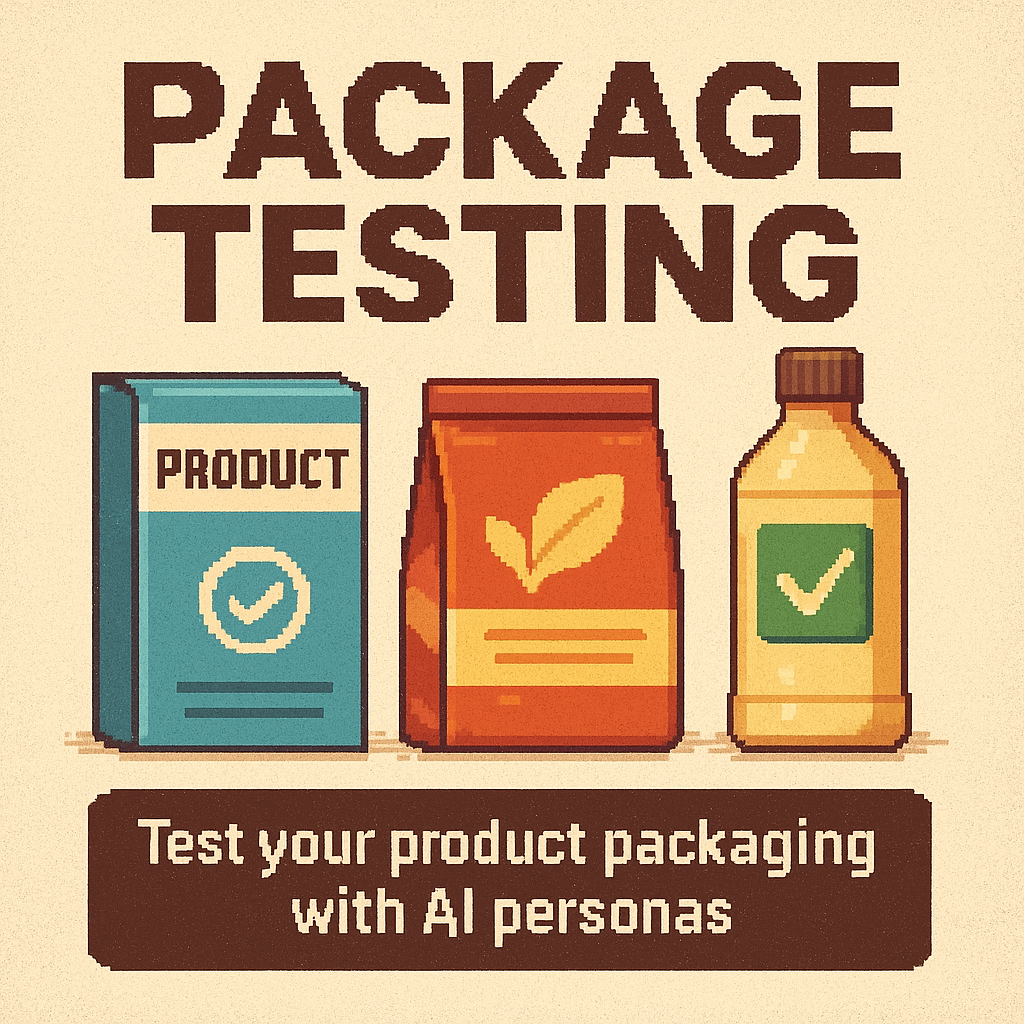Package Testing
Test and optimize your product packaging using AI personas before launch. This synthetic research approach reveals which package designs drive the strongest consumer appeal, shelf standout, and purchase intent across different contexts and audience segments without the cost and complexity of traditional package testing with real respondents.

What is it Used For?
Package testing evaluates consumer response to packaging designs before launch, helping businesses maximize shelf appeal, brand communication, and purchase conversion. This market research methodology validates packaging concepts by measuring visual appeal, message clarity, and competitive standout among target audiences. Companies use package testing to screen multiple design directions and identify winners before investing in production and launch costs, test different visual approaches, messaging strategies, and structural formats to find what resonates most strongly with different consumer segments, evaluate how packaging performs across various contexts like retail shelves, home kitchens, or office environments, assess brand communication effectiveness and ensure packaging delivers the intended brand positioning, validate emotional impact and purchase intent to predict real-world sales performance, and reduce the risk of costly packaging failures by catching design problems before market launch. The methodology works particularly well for consumer packaged goods, food and beverage products, personal care items, household goods, and any product where packaging significantly impacts purchase decisions and brand perception at the point of sale.
Real-World Example
How to Conduct This Research in Ask Rally
Step 1: Define Your Package Testing Scope
Start by clearly defining what elements you want to test - complete package designs, specific visual elements, messaging approaches, or structural formats. Consider your product category, target audience, competitive landscape, and the specific business decisions your testing needs to inform.
Step 2: Generate Your Target Personas
Create AI personas that represent your target consumer segments. Include demographics, psychographics, shopping behaviors, and usage contexts. For comprehensive testing, generate 200-500 personas across different segments to capture market diversity and understand how packaging appeals to different consumer types.
Step 3: Prepare Your Package Variations
Develop multiple packaging concepts or variations to test. Include different visual approaches, messaging strategies, color schemes, structural formats, and brand positioning elements. Test 3-8 variations depending on your scope - enough to identify clear winners without overwhelming personas.
Step 4: Present Packages in Context
Show packaging in realistic scenarios where consumers would encounter it - on retail shelves, in home environments, in office settings, or in e-commerce listings. Context significantly impacts how packages are perceived and which design elements drive appeal.
Step 5: Measure Core Package Performance Metrics
Evaluate each design on dimensions that predict market success: visual appeal and attention-grabbing power, message clarity and brand communication, competitive standout and differentiation, purchase intent and likelihood to choose, emotional impact and brand association, and contextual appropriateness for different environments. Ask personas to explain their reasoning to understand performance drivers.
Step 6: Test Across Different Contexts
Evaluate how the same packaging performs in different scenarios - retail shelf displays, home pantry storage, office break rooms, or online product listings. Understanding contextual performance helps optimize for your primary sales channels and usage environments.
Step 7: Segment Performance by Audience
Analyze how different persona segments respond to each packaging variation. Look for designs that work across all segments or identify opportunities to use different packaging for different target audiences or market channels.
Step 8: Analyze Design Element Performance
Beyond overall package appeal, identify which specific elements drive positive response - colors, typography, imagery, layout, messaging, or structural features. Understanding what makes packages work helps optimize future design development.
Step 9: Validate Shelf Impact
Test packages in competitive shelf sets to understand real-world standout and selection probability. Measure not just individual package appeal but how well designs perform when competing for attention against category alternatives.
Step 10: Iterate Based on Insights
Use persona feedback to refine winning concepts and address weak points. Test improved versions to validate enhancements before finalizing your package design for production and launch.
Starter Prompt Template
Use this prompt template to get started with package testing in Ask Rally:
Stay Updated
Subscribe to our newsletter to get notified about new articles and updates.
